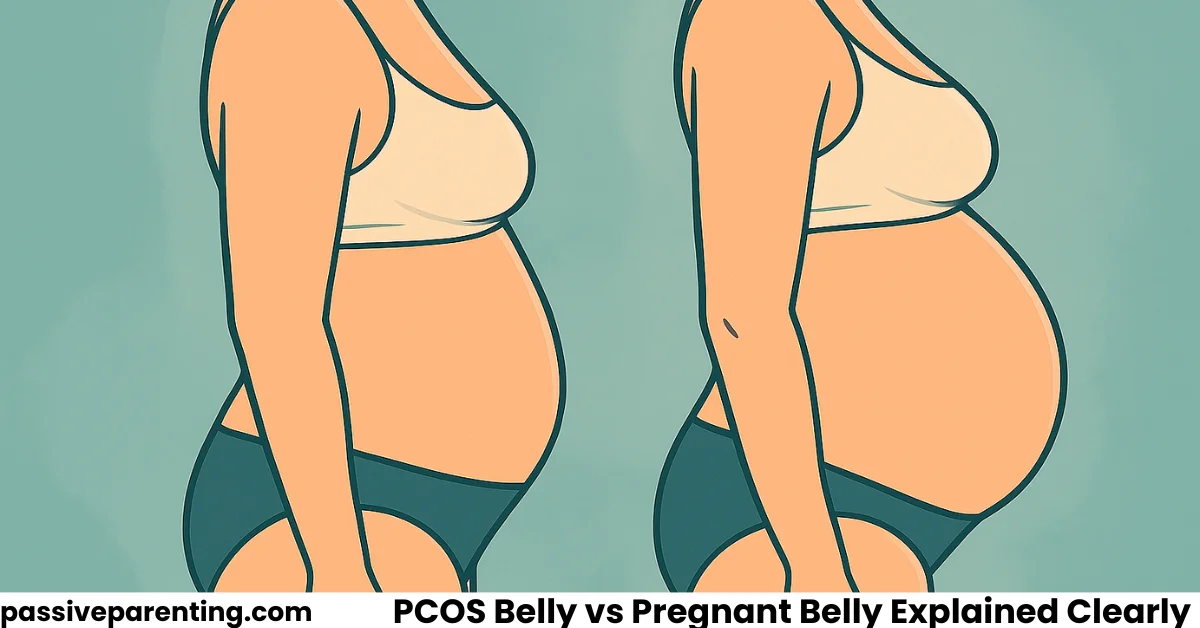Noticing changes in your stomach area can be confusing, especially when you are wondering whether your body is reacting to hormones or preparing for a baby. Many women experience uncertainty when comparing a PCOS belly vs pregnant belly because both can involve bloating, swelling and sudden fullness. But while they may look similar at first glance, their causes, timing and body signals differ in meaningful ways.
This guide simplifies the differences and helps you understand your body with confidence and kindness. You will learn how each condition develops, what signs to watch, and when to seek proper medical guidance.
What Is PCOS and Why It Affects the Belly
Polycystic ovarian syndrome is a hormonal imbalance that affects many women globally. It influences how ovaries work and how the body processes insulin. As a result, the abdomen may become a common area for fat storage and swelling.
How PCOS Creates Belly Changes
- Hormonal imbalance increases fat storage in the lower stomach
- Insulin resistance triggers abdominal fat gain
- Water retention and bloating create a swollen look
- Weight often gathers around the waistline
- Digestive discomfort can make the belly look bigger during the day
A PCOS belly often feels soft, puffy, and may change size throughout the day depending on meals, stress or hormonal shifts.
Understanding Pregnancy Belly Growth
During pregnancy the uterus grows to support the developing baby, creating a rounded and firm bump. The belly shape is more centralized and rises gradually upward over time.
How Pregnancy Belly Develops
- A firm bump begins forming below the belly button
- Growth becomes visible gradually over weeks
- Belly expands forward like a round curve
- Tenderness in breasts and morning sickness often accompany bloating early on
Unlike PCOS, pregnancy involves consistent belly growth and rarely goes down throughout the day.
PCOS Belly vs Pregnant Belly at a Glance
| Feature | PCOS Belly | Pregnant Belly |
|---|---|---|
| Texture | Soft, bloated, squishy | Firm, round and tight |
| Timing | Fluctuates daily | Steady, gradual growth |
| Period Cycle | Irregular cycles common | Missed period usually first sign |
| Additional Signs | Hair growth, acne, fatigue, cravings | Nausea, food sensitivity, fatigue, tender breasts |
| Belly Shape | Wider across the lower abdomen | More centered and rounded, expanding upward |
Key Differences to Notice
Belly Feel and Shape
A PCOS belly feels soft and spongy. It spreads across the lower stomach and can appear larger in the evening or after eating.
A pregnant belly feels firm and has a lifted rounded look, often starting as a small bump low in the abdomen then expanding outward.
Timing of Appearance
PCOS Belly Timing
- Can appear at any time
- Often fluctuates due to food, stress or hormones
- May come and go in waves
Pregnancy Belly Timing
- Belly usually shows after several weeks
- Does not shrink throughout the day
- Consistently grows over time
Period and Cycle Differences
With PCOS irregular periods are common, making pregnancy knowledge tricky. With pregnancy the first clear sign is typically a missed period followed by consistent physical changes.
Shared Symptoms That Cause Confusion
Some signs overlap between a PCOS belly vs pregnant belly such as:
- Bloating
- Morning heaviness
- Fatigue
- Mood shifts
- Cravings
This is why belly observation alone cannot confirm either. Considering the full body picture matters.
Early PCOS Belly Signs
- Lower abdominal fullness
- Cramping without a period
- Unpredictable cycles
- Acne and hair growth
- Sudden hunger or blood sugar swings
Early Pregnancy Belly Signs
- Missed period
- Nausea or morning sickness
- Breast tenderness
- Heightened sense of smell
- Swelling in the lower belly
- Light implantation spotting in early stages
When To Take a Pregnancy Test If You Have PCOS
PCOS can delay or disrupt periods, making test timing confusing. You may consider a pregnancy test if:
- Your period is missing longer than your usual pattern
- You feel consistent pregnancy associated symptoms
- Your belly swelling feels firmer or more centralized
- There is persistent nausea or breast sensitivity
If unsure, waiting two weeks after suspected ovulation before testing often gives clarity.
When To See a Healthcare Provider
You should seek medical advice if you experience:
- Persistent lower abdominal pain
- Rapid unexplained belly swelling
- Irregular bleeding or severe cramps
- Sudden dizziness or fainting
- Signs of pregnancy with PCOS and uncertainty
Professional evaluation ensures you receive accurate care rather than guessing.
Caring for a PCOS Belly
Lifestyle habits play a role in managing PCOS belly swelling. Helpful practices include:
- Balanced meals that support blood sugar balance
- Regular movement such as walking or gentle strength exercises
- Adequate hydration
- Stress management through breathing or mindful activities
- Quality sleep to support hormonal regulation
These steps are not quick fixes but support long term body balance.
Supporting a Healthy Pregnancy Belly
During pregnancy gentle health choices boost comfort and growth:
- Nutritious food choices
- Staying hydrated
- Moderate activity approved by doctors
- Plenty of rest
- Emotional support
Nurturing both body and wellness matters.
Emotional Experience of Belly Changes
Whether from PCOS or pregnancy, sudden body changes can bring:
- Confusion
- Excitement
- Anxiety
- Self consciousness
- Curiosity
Your feelings are valid. Your body is responding to hormones and your health journey deserves patience and understanding.
PCOS Belly vs Pregnant Belly in Simple Words
A helpful way to remember:
A PCOS belly is soft, bloated and changes size.
A pregnant belly is round, firm and grows steadily.
If your belly feels different than normal and symptoms feel uncertain, seeking support helps you move forward confidently.
Final Thoughts
Learning the difference between a PCOS belly vs pregnant belly helps you understand your body better without guessing or stressing. Each belly change tells a story about hormones, health and life stages. If you are unsure what your body is signaling, gentle testing and professional guidance bring clarity.
You deserve peace and knowledge about your body. Trust your intuition, learn your rhythm and take care of yourself with compassion. When in doubt, ask a healthcare provider to help you navigate both possibilities confidently.




